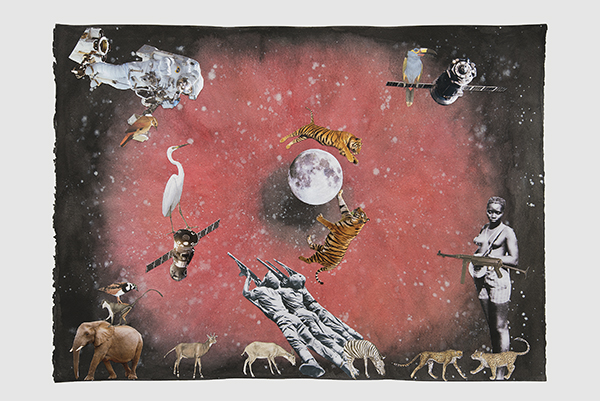"Deconstruction/Reconstruction"Mónica de Miranda
SABRINA AMRANI
Calle Madera 23. 28004 Madrid, SpainT: +34 627 539 884 e-mail:


12 December, 2020 > 16 January, 2021

Sabrina Amrani is delighted to present the online viewing room Mónica de Miranda: Deconstruction/Reconstruction, a complement to the artist's IRL exhibition All that Burns Melts into Air, currently on show at the gallery space.
To really understand an artwork, we need to know its context. And, in Mónica de Miranda's pieces, the places that each photography shows have a history of their own. In this sense, Deconstruction/Reconstruction brings to attention the unique conditions of the places the artist has visited in order to create her works. Through a deconstruction with a post-colonial gaze, Mónica de Miranda proposes a reconstruction of the cartography of her affections.
Across her investigations on the Afro-Portuguese world, Mónica de Miranda’s works creates a space for debate on the historical relation between Portugal and its former colonies, informed by the artist's own experience. De Miranda draws addresses bodies, ideas, and emotions, hinting at the fact that most of those in the path of the empire did not have the power to change history.
De Miranda body of works talks about exile, dislocation, and displacement, as well as the genre of travel. Her narrative mode sits strategically between fiction and documentary, exceeding the possibilities permitted by realism in order to get as close as possible to a truth that eludes traditional documentary and autobiographical practices. Her photographs are, thus, imagined autobiographies that narrate her experiences of being out of place, as well as the possibilities opened up by the enriching processes of contact. Various figures -sexual and romantic attachments, as well as de Miranda’s’ friends– who come in and out of the frames, also act as conduits to temporary homes, especially in the absence of the familiar, reflecting psychological and emotional considerations about the effects of being a product of amalgamation and erasure. In her films, she relies on visual strategies to explore the significance of cityscapes, landscapes, and oceanic bodies to deconstruct the self-through memory, imagined reconstruction, physical return, and creative production.
Mónica De Miranda’s films and photographs form an unusual arc that warrants methodological attention to the complex ways in which she uses visual vocabulary to address the persistence of uncanny reminders of past encounters, and the ways in which these “reminders” continue to make themselves present in both Portugal and its colonies. Portugal cast a shadow over a spectrum of the world, with large landmasses and islands that became colonial possessions that now are Angola, Mozambique, Guinea-Bissau, and Cape Verde Islands in Africa; Brazil and a plethora of islands in South America; smaller territories and coastal cities in South Asia: Goa in India, Colombo in Sri Lanka, and Macao in China; among dozens of others. In each of these locations, the Portuguese disrupted existing trades linkages, monopolising sea routes. In the artist’s works, we see traces of the restless expeditions that the Portuguese made five centuries ago, and the colonial wound that still lasts today.
To really understand an artwork, we need to know its context. And, in Mónica de Miranda's pieces, the places that each photography shows have a history of their own. In this sense, Deconstruction/Reconstruction brings to attention the unique conditions of the places the artist has visited in order to create her works. Through a deconstruction with a post-colonial gaze, Mónica de Miranda proposes a reconstruction of the cartography of her affections.
Across her investigations on the Afro-Portuguese world, Mónica de Miranda’s works creates a space for debate on the historical relation between Portugal and its former colonies, informed by the artist's own experience. De Miranda draws addresses bodies, ideas, and emotions, hinting at the fact that most of those in the path of the empire did not have the power to change history.
De Miranda body of works talks about exile, dislocation, and displacement, as well as the genre of travel. Her narrative mode sits strategically between fiction and documentary, exceeding the possibilities permitted by realism in order to get as close as possible to a truth that eludes traditional documentary and autobiographical practices. Her photographs are, thus, imagined autobiographies that narrate her experiences of being out of place, as well as the possibilities opened up by the enriching processes of contact. Various figures -sexual and romantic attachments, as well as de Miranda’s’ friends– who come in and out of the frames, also act as conduits to temporary homes, especially in the absence of the familiar, reflecting psychological and emotional considerations about the effects of being a product of amalgamation and erasure. In her films, she relies on visual strategies to explore the significance of cityscapes, landscapes, and oceanic bodies to deconstruct the self-through memory, imagined reconstruction, physical return, and creative production.
Mónica De Miranda’s films and photographs form an unusual arc that warrants methodological attention to the complex ways in which she uses visual vocabulary to address the persistence of uncanny reminders of past encounters, and the ways in which these “reminders” continue to make themselves present in both Portugal and its colonies. Portugal cast a shadow over a spectrum of the world, with large landmasses and islands that became colonial possessions that now are Angola, Mozambique, Guinea-Bissau, and Cape Verde Islands in Africa; Brazil and a plethora of islands in South America; smaller territories and coastal cities in South Asia: Goa in India, Colombo in Sri Lanka, and Macao in China; among dozens of others. In each of these locations, the Portuguese disrupted existing trades linkages, monopolising sea routes. In the artist’s works, we see traces of the restless expeditions that the Portuguese made five centuries ago, and the colonial wound that still lasts today.
 |
Mónica de Miranda |
mpefm
SPAIN art press release
Opening:
Tuesday to Friday from 11 a.m. to 7 p.m. Saturdays from 11 a.m. to 2.30 p.m.
Online VIEWING ROOM

Online VIEWING ROOM
QR of this press release
in your phone, tablet








